Do you want to upgrade your gardening game? Consider constructing a raised garden bed. It's an excellent solution for city dwellers surrounded by asphalt and cement. Also most people with large yards can also benefit from boosting their plants.
Growing plants in elevated growing spaces, or "raised beds," has become increasingly popular for gardeners in recent years. Growing plants in elevated beds is a common and flexible technique. Raised bed gardens can turn a dull area or yard into a lush, fruitful oasis.
Moreover, raised garden beds enable you to plant almost everything, even with limited area. So, let's start with our raised bed gardens today and grow our own food!
Types of Raised Garden Beds
Wooden Raised Beds:
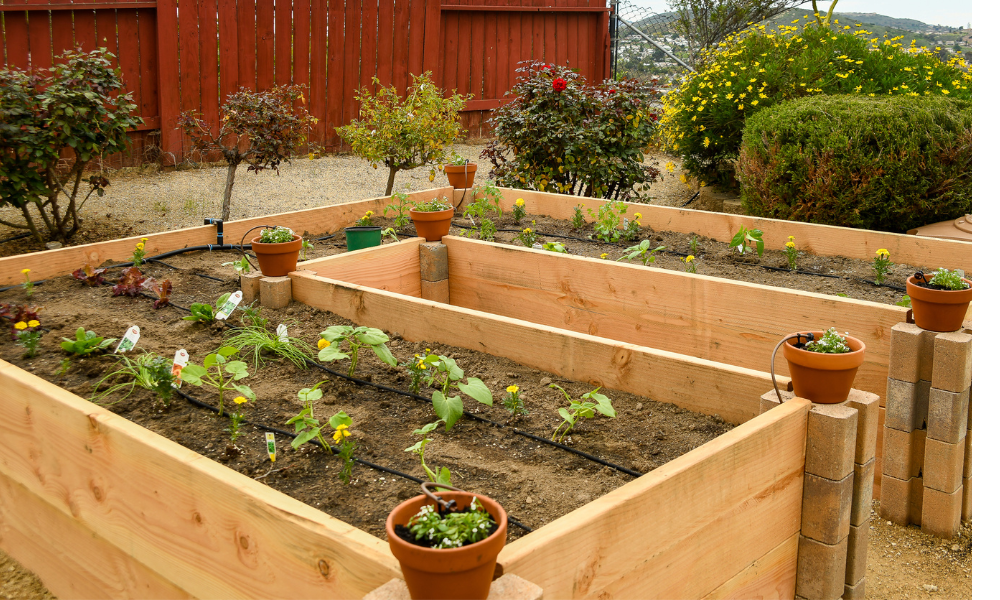
These are the most common raised bed types, typically made from rot-resistant wood such as cedar, redwood, or treated pine. They can be built in different sizes, material or shape and are easily customized.
Metal Raised Garden Beds:
Metal is a solid material, durable and long-lasting. They can be more expensive than wooden raised beds but require less maintenance. Some are often made from materials such as galvanized steel and will last for years. Metal raised beds painted with an anti-rust coating also take years before they will start rusting. You can enjoy years of gardening before you replace it.
Concrete Raised Garden Beds:
These are sturdy and long-lasting and can be used to build sturdy raised beds of assorted sizes, or shapes. They are a good option if you want a permanent fixture, sturdy raised bed or beds that last many years.
Brick Raised Garden Beds:
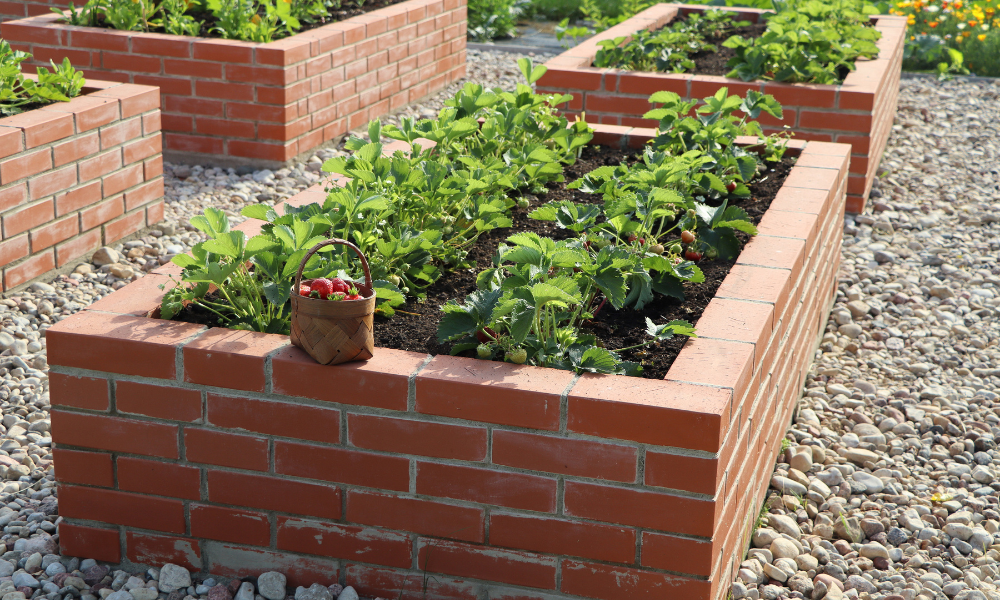
These are a popular choice for adding a decorative element to your garden. They can be used to fill or create curved or angled shapes and can be built to any height, size, or shape.
Recycled Raised Garden Beds:
To build long-lasting, practical growing spaces without breaking the bank, you can use recycled material to construct raised garden beds. Reduce your environmental impact by recycling wood, old tires, and plastic into raised beds.
Recycled plastic can mimic the appearance of wood without the risk of rotting or the requirement for chemical treatments. Recycled plastic and metal are a long-lasting, and low-maintenance options for raised beds.
Fabric Raised Garden Beds:
These are lightweight and easy to set up and can be used to create temporary raised beds. They are well constructed and typically made from a breathable fabric that allows water and air to pass through.
Tiered Raised Garden Beds
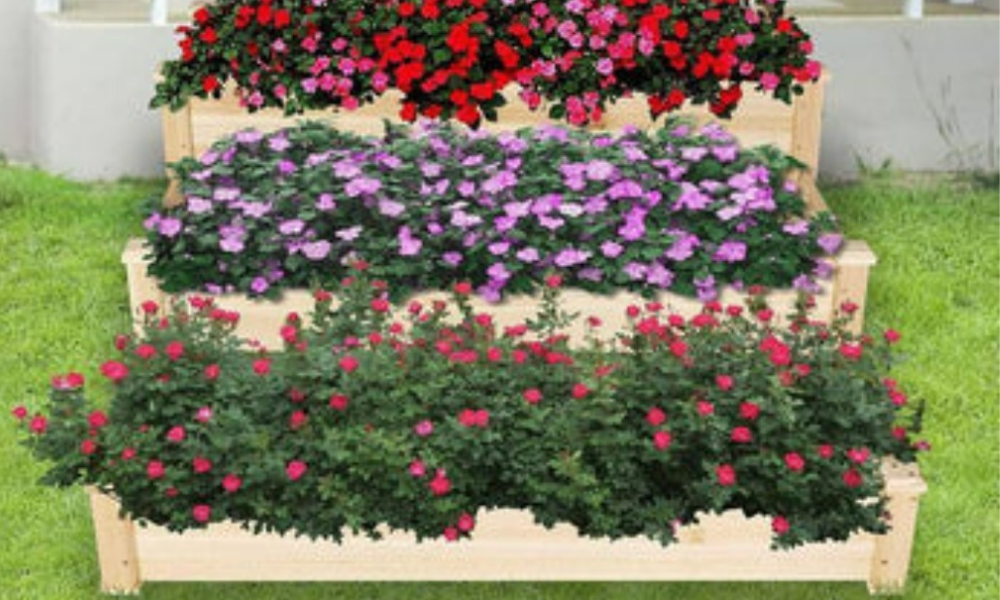
Tiered raised beds are a creative and visually appealing way to maximize your gardening space while also creating a magnificent focal point for your outside environment. They comprise several layers or tiers, each constructed at a different height, to create a dynamic, cascading appearance.
When choosing a raised bed, consider the type of plants you want your garden bed to grow, the size and shape of your garden, the material, and your budget.
Factors to Consider When Choosing a Raised Garden Beds
- Size: The size of the raised beds should match the size of your garden and the number of plants you want to grow. Make sure the raised garden beds are large enough to accommodate the plants you plan to grow.
- Height: Consider the height of the raised beds, especially if you have mobility issues or plan to grow crops requiring deeper soil. Raised garden beds can be built at different heights to suit your needs.
- Material: The material used to construct the raised beds can affect its durability, cost, and appearance. Consider whether you want raised garden beds made from wood, metal, concrete blocks, or other materials. Ensuring solid material enables you to use your garden beds for longer period.
- Drainage: The raised beds should have adequate drainage to prevent waterlogging, which can damage plants. Consider the type of soil in your garden and the amount of rainfall in your area when choosing a raised garden bed.
- Maintenance: Consider the level of maintenance required for the raised beds. Some materials may require more maintenance than others, such as cedar wood that needs to be sealed or painted regularly to prevent your raised garden beds from rotting.
- Cost: The cost of the raised beds is a key factor to consider. Some materials may be more expensive, and the cost can vary depending on the size and design of raised garden beds
Considering these factors, you can choose a raised bed that is right for your needs and will provide a healthy environment for your plants to thrive.
Benefits of Raised Garden Beds
Raised beds are a game changer for both gardening enthusiasts and green-thumb beginners! Here are some benefits of raised garden beds
Improved Soil Quality:
Raised beds allow you to create a customized soil mix, offering the benefits of better drainage, aeration, and fertility. This ensures that your plants have the ideal growing conditions to thrive. The soil is free of weeds and pests, and it is easier to maintain soil fertility and nutrient levels.

Enhanced Pest Control:
Raised beds make it more challenging for ground-dwelling pests, like slugs and snails, to destroy your plants. In addition, filling your garden bed with dirt or mulch will protect and deter burrowing pests like moles and gophers.
Reduced Soil Compaction:
Raised garden beds prevent soil compaction by eliminating the need to walk on the ground. This allows for better root growth and nutrient absorption, leading to healthier and more productive plants.
Raised garden beds are designed with adequate drainage, which prevents excess waterlogging and soil compaction compared to in ground gardening. This promotes healthy root growth and prevents soil-borne diseases.
Easier Weed Management:
By filling your raised beds with fresh, clean soil and compost, you can significantly reduce soil contamination and the number of weed seeds present in the planting area. The elevated height also makes it easier to spot and remove any annoying weeds that do appear.
Increased Yield:
The improved soil quality and optimal growing conditions in raised garden beds often result in higher fruit and vegetable yields than in traditional gardens. By including raised beds in your gardening approach, you may provide an ideal environment for your plants to flourish, resulting in higher yields and more abundant produce.
Extended Growing Season:
The soil warms up faster in spring and retains heat longer into the fall, providing an extended growing season for most vegetables. Raised garden beds can be easily covered with protective covers or hoop houses, which extend the growing season and protect plants from frost or harsh weather conditions.
Ease of Accessibility:
Raised beds bring the garden to a comfortable working height, reducing the strain on your back and knees. Raised garden bed stand, makes planting, weeding, and harvesting easier. Moreover, raised garden beds make gardening more enjoyable and accessible for people with mobility issues or difficulty bending or kneeling.
Versatility:
Raised beds can be built in various shapes and sizes, making them suitable for small urban spaces or sprawling rural gardens. They can even be placed above ground or on hard surfaces like concrete or patios. Raised garden beds can be customized to fit your garden space and plant preferences.

Aesthetic Appeal:
Raised beds can be designed with various materials and styles, adding a touch of charm and visual interest to your garden. They also help create defined, organized growing spaces that are functional and attractive. Raised garden beds can add a decorative element to your garden, especially if you choose a material and design that complements your outdoor space.
Overall, raised garden beds are a great option for gardeners who want to improve the quality and yield of their crops and herbs, while also enjoying easier access and a more aesthetically pleasing garden space.
Preparing the site for your raised beds
Preparing the site for your raised beds is important in creating a healthy environment for your plants to grow. Here are some steps to follow when preparing the site for your raised beds:
- Choose the location: Select a location that receives at least six hours of sunlight a day, has good drainage, and is easily accessible for planting, watering, and harvesting.
- Clear the area: Remove any grass, weeds, or debris from the area where you plan to place the raised bed. You can use a shovel or a garden tiller to loosen the soil and remove the roots.
- Level the ground: Make sure the ground is level and even. If the site is on a slope, you may need to use retaining walls or additional soil to level the area.
- Add soil: If the soil in the area is poor, you may need to add soil to the site. Use a soil mix specifically designed for raised garden beds, typically including a blend of topsoil, compost, and other organic materials.
- Build the raised bed: Once the site is prepared, you can set up or build the raised bed. Follow the manufacturer's instructions if you are using a prefabricated kit or build the bed from scratch using materials such as wood, brick, or stone.
- Add mulch: Once the raised bed is in place, add a layer of organic mulch on top of the soil. This will help retain moisture, suppress weeds, and provide plant nutrients.
By following these steps, you can prepare a site for plant roots in your raised bed that ensures your garden plants are healthy and thrive.
Our Curated and Affordable Raised Garden Beds
1. Vertical Raised Garden Bed with Wheels-5 Tier
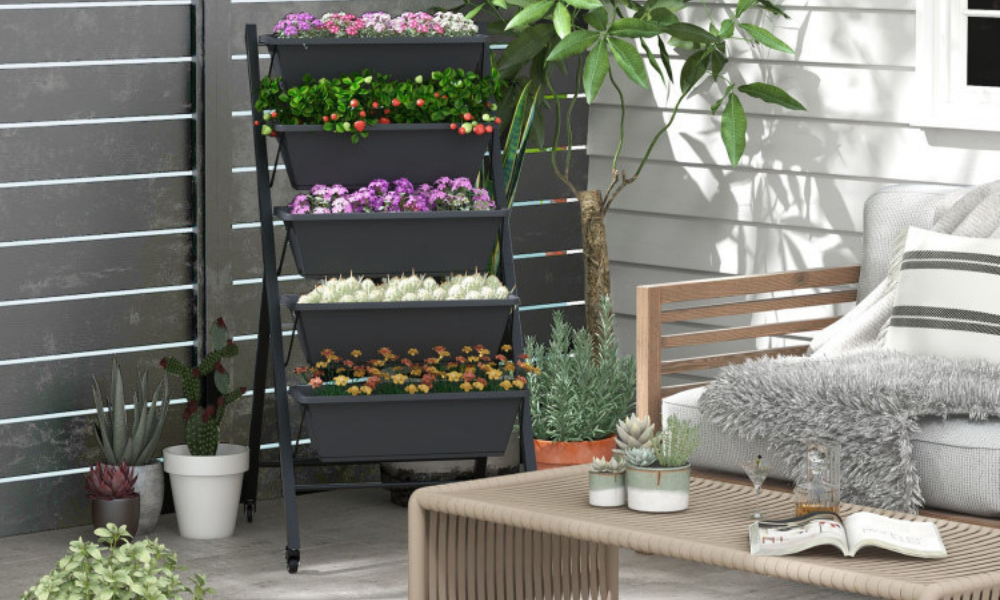
The Vertical Raised Garden Bed with wheels suits various locations, including the garden, courtyard, front porch, balcony, greenhouse, deck, and more. This raised garden bed lets you plant your favorite flowers, vegetables, and herbs.
Each container box is designed with a removable tray with drainage holes. It has two wheels allowing you to move easily anywhere you want. Two wheels can be locked when you find the perfect spot for the garden bed.
2. Raised Bed Garden with Trellis
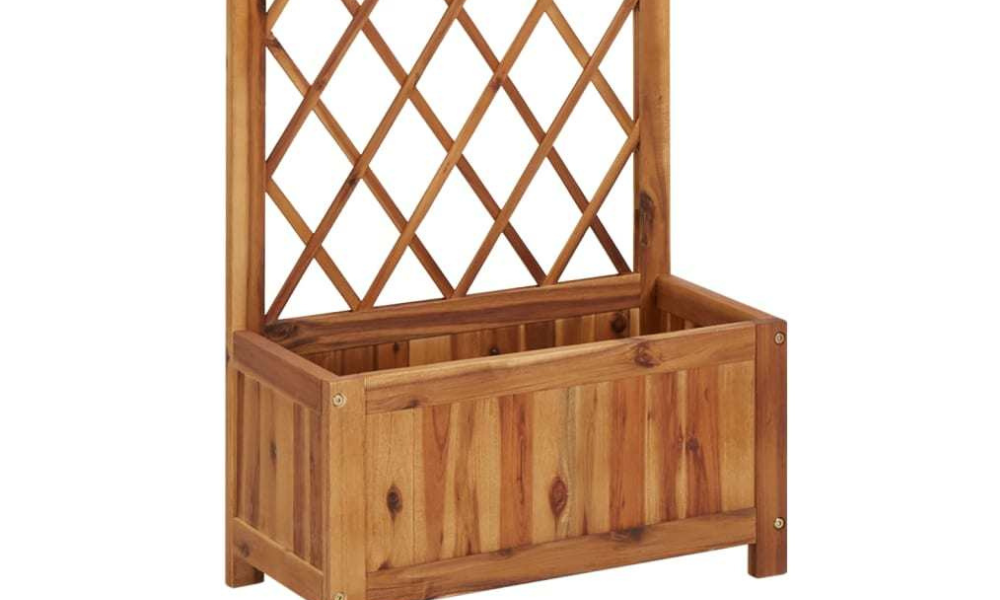
This Raised Bed Garden with Trellis is made from acacia wood and is smart and stylish choice to grow more foods without much space. Not only will you have healthier plants, but this raised bed also makes it easier to harvest your produce. Additionally, it adds visual interest and beauty to your backyard
3. Planter Box, Raised Garden Bed with Wheels

This Planter Box is ideal for container gardening and other small-scale plantings. This metal Raised Garden Bed with Wheels offers a better growing environment for root crops, herbs, flowers, and other plants. The metal raised bed has drainage holes ensuring the plant roots will not rot. Additionally, the material of the stand ensures unparallel durability offering a longer period of planting your favorite plants.
4. 2 Pcs Plastic Raised Garden Bed

The 2Pcs Plastic Raised Garden Bed lets you enjoy a beautiful full-color flower display while at the same time harvesting fresh and healthy vegies and herbs. They have a drainage holes allow for air circulation, preventing root rot and promoting healthy plant growth. These raised beds are perfect for any small area such as patio, balcony, etc.
5. Circular Garden Bed
Enhance your backyard garden with Circular Garden Bed. The Planter Box is perfect for small spaces for planting vegetables, flowers, and herbs; these boxes are easy to assemble and offer a convenient way to grow your flowers or produce in a limited space.

Conclusion
Finally, when selecting raised beds for gardening, you must consider different factors. These include the depth of the raised beds, material, style, and design. Consider the location of the raised bed and the type of soil you'll need.
Additionally, the extra features or extras you want to add. Embrace the power of raised beds and transform your gardening experience. You can yield happier plants and enjoy time cultivating your green oasis.
With these resources, you'll be able to find affordable yet durable garden beds. Visit Hardy Garden now and you will find the best raised garden beds and gardening tools for your successful garden endeavor. Start growing your food today and enjoy bountiful produce even with minimal space.





Share and get 15% off!
Simply share this product on one of the following social networks and you will unlock 15% off!